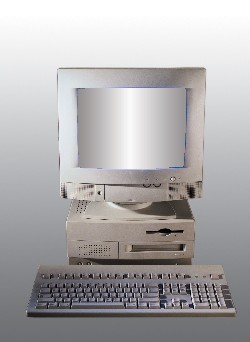Has the revolution in information technology placed a larger population at risk for glaucoma? A Japanese study in the Journal of Epidemiology and Community Health raises that possibility.
The researchers performed the study on 10,202 Japanese workers, who were screened for visual field abnormalities (VFA) using frequency-doubling technology (FDT). Participants also underwent a general medical check-up and ophthalmologic exam.
In addition, they completed questionnaires and interviews regarding their history of ocular disease, family history of glaucoma, symptoms of migraine, smoking habits, alcohol consumption and their history of computer use.
Complete medical data was available for 522 and 8,602 subjects who were positive and negative for visual field abnormalities, respectively. The researchers found a significant interaction between heavy computer use and refractive errors and the risk of VFA. Heavy computer users with refractive errors showed a significant positive association with VFA while those without refractive errors did not.
The researchers performed the study on 10,202 Japanese workers, who were screened for visual field abnormalities (VFA) using frequency-doubling technology (FDT). Participants also underwent a general medical check-up and ophthalmologic exam.
In addition, they completed questionnaires and interviews regarding their history of ocular disease, family history of glaucoma, symptoms of migraine, smoking habits, alcohol consumption and their history of computer use.
Complete medical data was available for 522 and 8,602 subjects who were positive and negative for visual field abnormalities, respectively. The researchers found a significant interaction between heavy computer use and refractive errors and the risk of VFA. Heavy computer users with refractive errors showed a significant positive association with VFA while those without refractive errors did not.
 |
The authors point out that myopia is a potent risk factor for open-angle glaucoma, and that forces in myopic eyes might cause structural weakness of the optic disc, fluctuation of IOP and microcirculatory disturbance. Further, use of a video display terminal might influence physical and mental health problems, such as blood pressure and mood disturbance, which also have been reported as possible risk factors for glaucoma. Therefore, the optic nerve in myopic eyes might be structurally more susceptible to computer stress than the nerve in non-myopic eyes.
Optometrist James L. Fanelli, of Wilmington, N.C., author of Review of Optometrys Glaucoma Grand Rounds, conjectures that the study shows a greater link between glaucoma and myopia than between glaucoma and computer use.
Other studies have suggested that myopic Japanese patients are at higher risk of developing glaucoma than non-myopic Japanese patients. So, its possible that patients in this study had a higher incidence of glaucoma because they were nearsighted, not because they were heavy computer users, he says.
The study raises some interesting questions about the potential susceptibility of the lamina cribrosa to external mechanical forces, Dr. Fanelli adds. Other researchers are looking specifically at biomechanical forces at the level of the optic nerve to determine what, if any, role they play in laminar remodelling and subsequent nerve fiber layer loss. The structural integrity and reliability of the sclera and lamina cribrosa may play a significant role in setting the stage for protecting the nerve fibers that pass through the lamina, he says.
The researchers acknowledge that the study had several limitations, namely that the study design was cross-sectional, comparatively few women were studied, refractive errors were not determined ophthalmologically, and a large number of glaucoma patients are undiagnosed, making it harder to obtain an accurate family history of glaucoma. These limitations warrant further studies to confirm the findings, the researchers say.
Optometrist James L. Fanelli, of Wilmington, N.C., author of Review of Optometrys Glaucoma Grand Rounds, conjectures that the study shows a greater link between glaucoma and myopia than between glaucoma and computer use.
Other studies have suggested that myopic Japanese patients are at higher risk of developing glaucoma than non-myopic Japanese patients. So, its possible that patients in this study had a higher incidence of glaucoma because they were nearsighted, not because they were heavy computer users, he says.
The study raises some interesting questions about the potential susceptibility of the lamina cribrosa to external mechanical forces, Dr. Fanelli adds. Other researchers are looking specifically at biomechanical forces at the level of the optic nerve to determine what, if any, role they play in laminar remodelling and subsequent nerve fiber layer loss. The structural integrity and reliability of the sclera and lamina cribrosa may play a significant role in setting the stage for protecting the nerve fibers that pass through the lamina, he says.
The researchers acknowledge that the study had several limitations, namely that the study design was cross-sectional, comparatively few women were studied, refractive errors were not determined ophthalmologically, and a large number of glaucoma patients are undiagnosed, making it harder to obtain an accurate family history of glaucoma. These limitations warrant further studies to confirm the findings, the researchers say.
Tatemichi M, Nakano T, Tanaka K, et al. Possible association between heavy computer users and glaucomatous visual field abnormalities: a cross sectional study in Japanese workers. J Epidemiol Community Health 2004 Dec;58(12):1021-7.
Vol. No: 141:12Issue:
12/15/04

